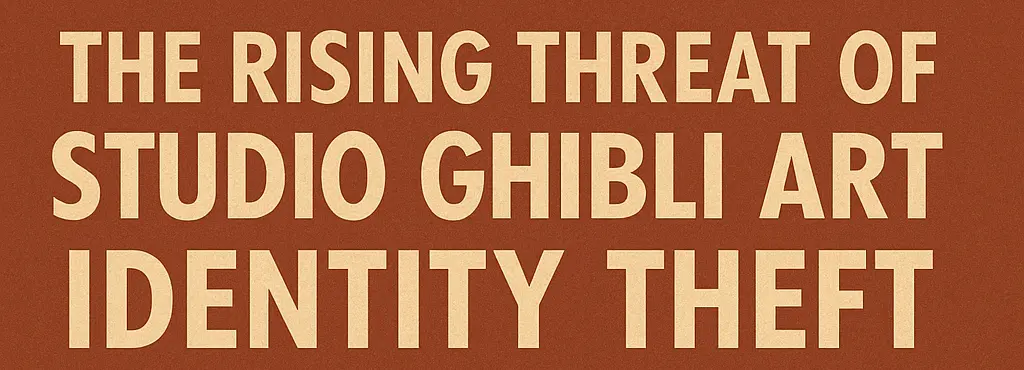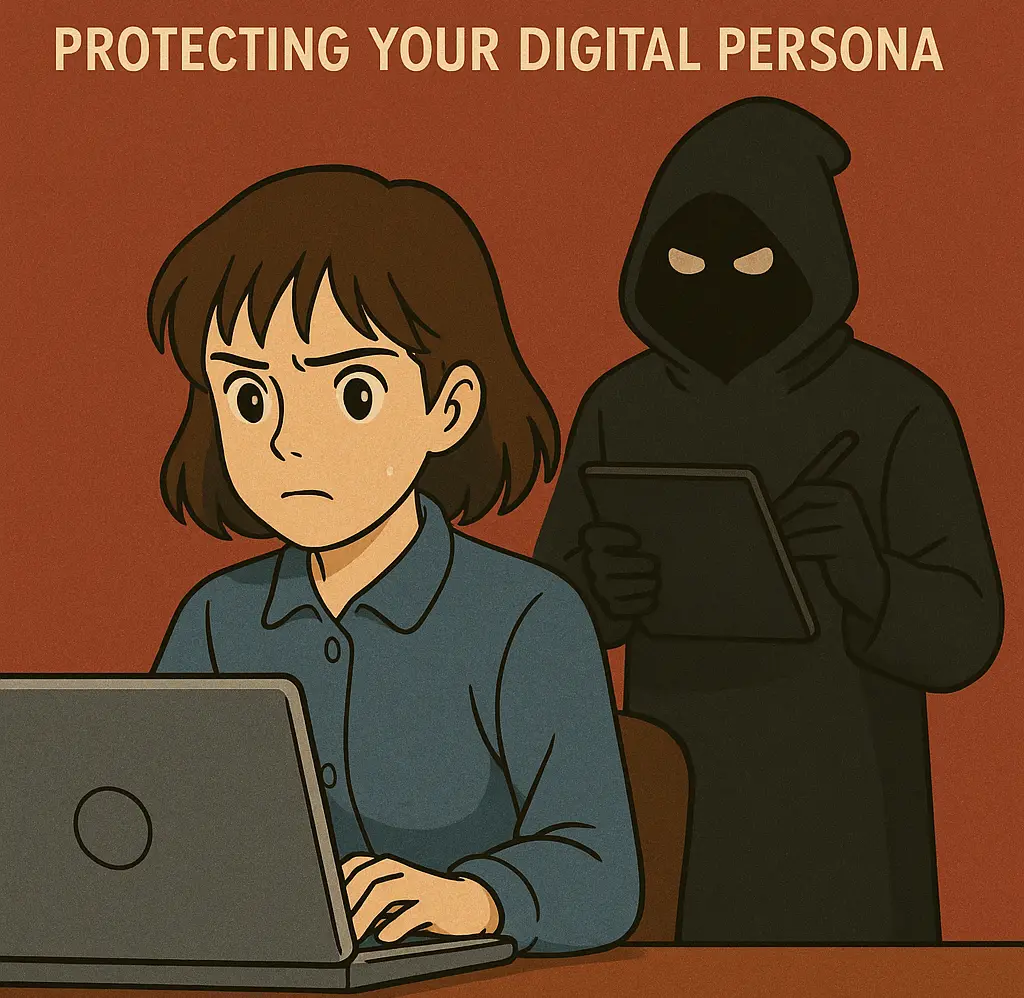The most popular Japanese image generation The Ghibli style is dangerous for everyone, You are very happen when you upload your image in ChatGPT and covert image in a new style, but this is not a happy thing, technology evolves very fast, and changes day to day, companies focus to take more data and try to provide attractive options where people upload own image
In today’s digital world, a concerning trend has emerged at the intersection of beloved animation styles and personal identity: Ghibli-style identity theft. This practice involves manipulating someone’s photos to appear in the distinctive style of Studio Ghibli animations, often without consent, and potentially for harmful purposes. This article explores how this specific form of digital manipulation affects individuals, the technology behind it, and what you can do to protect yourself.
How Studio Ghibli Art Is Being Used for Identity Theft
Studio Ghibli art has a distinctive visual style characterized by soft watercolor backgrounds, expressive characters, and a dreamlike quality that has captivated audiences worldwide. Unfortunately, this recognizable aesthetic is now being exploited by bad actors through several methods:
AI-Generated Studio Ghibli Transformations

Modern AI image generators can transform ordinary photographs into images that mimic Studio Ghibli art with remarkable accuracy. Scammers use these tools to:
- Convert stolen profile pictures into Ghibli-style portraits
- Create entirely fictional personas with the warm, trustworthy aesthetic of Studio Ghibli art
- Generate convincing “proof” of identity that appears hand-drawn and artistic
Read More: Define Phishing: Understanding and Mitigating Online Threats
Social Engineering Through Nostalgic Appeal
The emotional connection many people have with Studio Ghibli art makes it particularly effective for manipulation. Scammers leverage this by:
- Creating profiles using Ghibli-style avatars to establish immediate trust
- Crafting backstories that align with themes common in Studio Ghibli films (nature connection, personal journey, etc.)
- Using the innocent, whimsical associations of Studio Ghibli art to lower victims’ defenses
Counterfeit Verification
Some scammers create fake “verification” images showing a person holding ID cards or specific messages, but rendered in Studio Ghibli art style to disguise inconsistencies that might be obvious in realistic photos.
Why Studio Ghibli Art Is Particularly Effective for Scammers
Several factors make Studio Ghibli art especially useful for identity thieves:
Universal Positive Associations
Studio Ghibli art carries overwhelmingly positive cultural associations across different countries and age groups. Films like “Spirited Away,” “My Neighbor Totoro,” and “Howl’s Moving Castle” have created a global reservoir of goodwill that scammers can tap into.
Stylistic Ambiguity
The stylized nature of Studio Ghibli art creates a perfect middle ground where images look distinctive enough to seem personalized but abstract enough that inconsistencies with the real person being impersonated aren’t immediately obvious.
Trust Signaling
Research in social psychology suggests that people associate certain visual aesthetics with trustworthiness. The warm colors, natural elements, and expressive humanity in Studio Ghibli art trigger trust responses that scammers exploit.
Cross-Cultural Appeal
Studio Ghibli art transcends cultural boundaries, making it effective for international scamming operations that target victims across different countries.
Real-World Consequences
The impact of Studio Ghibli’s art identity theft can be severe:
Romance Scams
Victims report being deceived by profiles using Ghibli-style avatars in dating apps and social media, leading to emotional manipulation and financial fraud. The romantic, dreamy quality of Studio Ghibli art makes these profiles particularly effective for romance scams.
Fake Endorsements
Celebrities and influencers have had their likenesses transformed into Studio Ghibli art style and used to endorse products or investment schemes without their knowledge or consent.
Community Infiltration
Online communities centered around anime, animation, and Japanese culture have reported scammers using Studio Ghibli art personas to gain acceptance before exploiting members’ trust.
Financial Fraud
Investment scams using Studio Ghibli art aesthetics have targeted fans of Japanese culture, promising connections to exclusive anime-related investments or NFT projects.
How AI Tools Facilitate This Type of Theft
Modern AI systems like ChatGPT and image generators contribute to this problem in several ways:
Information Gathering
AI tools can scrape and synthesize information about Studio Ghibli art styles, making it easier for scammers to create convincing forgeries. These systems analyze thousands of frames from Ghibli films to learn the distinctive artistic elements.
Style Transfer Technology
AI image generators can now transform ordinary photos into Studio Ghibli art style with simple text prompts like “convert this photo to Studio Ghibli style” or “make this look like a Miyazaki character.”
Narrative Creation
Large language models can generate convincing backstories and conversation patterns that align with the themes and emotional tones of Studio Ghibli films, helping scammers maintain consistent personas.
Automation at Scale
These tools allow scammers to create dozens or hundreds of fake Studio Ghibli art identities with minimal effort, increasing the reach of their operations.
Protecting Yourself from Studio Ghibli Art Identity Theft

Here are practical steps to avoid becoming a victim:
Verify Beyond the Image
If someone presents themselves using Studio Ghibli art as their profile picture, request video calls or multiple photos from different angles before establishing trust.
Reverse Image Search
Use tools like Google Images, TinEye, or specialized AI art detectors to check if a Studio Ghibli art portrait is generated or manipulated.
Watch for Stylistic Inconsistencies
Genuine Studio Ghibli art has specific characteristics. Look for inconsistencies in line work, color palettes, or background elements that don’t match the studio’s authentic style.
Be Wary of Sudden Style Shifts
If someone previously used realistic photos and suddenly switches to Studio Ghibli art style representations, consider this a potential warning sign.
Check Digital Footprint Consistency
Legitimate individuals typically have consistent online presences across platforms. Be suspicious of profiles that exist only in Studio Ghibli art form with no verifiable history.
If Your Identity Has Been Stolen in Studio Ghibli Art Style
If you discover your likeness has been transformed into Studio Ghibli art and used without permission:
- Document all instances of the unauthorized use
- Report the content to the platforms where it appears
- File reports with relevant authorities like the FTC’s identity theft portal
- Consider sending cease and desist notices if the perpetrator is identifiable
- Alert your contacts that your identity may have been compromised
The Broader Ethical Questions
This phenomenon raises important questions about:
- The responsibility of AI developers in preventing misuse of style transfer technology
- The rights of both individuals and studios like Ghibli to control how their likenesses and artistic styles are used
- The need for better verification systems in digital spaces
- The balance between artistic expression and potential for harm
Conclusion
The misappropriation of Studio Ghibli art for identity theft represents a sophisticated evolution in digital deception. By combining the beloved aesthetic of Miyazaki’s creations with advanced AI technology, scammers have found a powerful tool for manipulation. However, with awareness, vigilance, and proper verification practices, we can protect ourselves and preserve the genuine joy that authentic Studio Ghibli art brings to millions around the world.
As we navigate this challenge, we must work toward technological and policy solutions that preserve the creative potential of AI while preventing its use for deception. Only then can we ensure that the magical worlds created by Studio Ghibli remain sources of inspiration rather than tools for exploitation.

Q / A – Section
Questions that are very helpful for everyone and clear some doubts…
What is Ghibli-style identity theft, and why is it a concern?
Ghibli-style identity theft refers to the unauthorized manipulation of someone’s photos into the distinctive Studio Ghibli animation style, often used by scammers for harmful purposes such as creating fake personas, romance scams, or financial fraud. It is a concern because it exploits the emotional and cultural trust associated with Studio Ghibli’s art to deceive people, leading to emotional, economic, and reputational damage.
How are scammers using AI technology to create Ghibli-style images for identity theft?
Scammers use modern AI image generators to transform stolen profile pictures into Studio Ghibli-style portraits, create fictional personas with a trustworthy aesthetic, and generate fake “verification” images that appear hand-drawn. AI tools also enable style transfer technology with simple prompts and automate the creation of multiple fake identities at scale.
Why is Studio Ghibli art particularly effective for scammers?
Studio Ghibli art is effective for scammers due to its universal positive associations, cross-cultural appeal, stylistic ambiguity (which hides inconsistencies), and inherent trust signaling. The warm colors, natural elements, and emotional resonance of Ghibli films lower victims’ defenses and make fake profiles seem more credible.
What are some real-world consequences of Ghibli-style identity theft?
Consequences include romance scams on dating apps using Ghibli-style avatars, fake endorsements by celebrities or influencers, community infiltration in anime or Japanese culture groups, and financial fraud through investment scams promising exclusive anime-related opportunities or NFTs.
How can individuals protect themselves from Ghibli-style identity theft?
To protect themselves, individuals should verify identities beyond images by requesting video calls or multiple photos, use reverse image search tools like Google Images or TinEye, watch for stylistic inconsistencies in Ghibli art, be cautious of sudden style shifts in profiles, and check for consistent digital footprints across platforms.
What steps should someone take if their identity has been stolen in Studio Ghibli art style?
If someone’s identity has been misused, they should document all unauthorized uses, report the content to relevant platforms, file reports with authorities like the FTC’s identity theft portal, send cease and desist notices if possible, and alert their contacts about the potential compromise.
What broader ethical questions does Ghibli-style identity theft raise?
This issue raises questions about the responsibility of AI developers to prevent misuse of style transfer technology, the rights of individuals and studios like Studio Ghibli to control their likeness and style, the need for better digital verification systems, and the balance between artistic expression and potential harm.
How does the rapid evolution of technology contribute to issues like Ghibli-style identity theft?
The rapid evolution of technology, particularly AI and image generation tools, enables scammers to easily replicate Studio Ghibli art styles, scrape information, and create convincing forgeries at scale. Companies’ focus on collecting more data and offering attractive features (like image uploads) can inadvertently provide scammers with more material to exploit.
What role do emotional and cultural connections play in the effectiveness of Ghibli-style scams?
Emotional and cultural connections to Studio Ghibli art, stemming from beloved films like “Spirited Away” and “My Neighbor Totoro,” make it a powerful tool for manipulation. Scammers leverage nostalgia and the innocent, whimsical associations of Ghibli art to build trust and lower victims’ defenses, making scams more effective.
What is the long-term goal for addressing challenges like Ghibli-style identity theft?
The long-term goal is to develop technological and policy solutions that preserve the creative potential of AI while preventing its misuse for deception. This includes raising awareness, enhancing verification practices, and ensuring that the joy and inspiration of Studio Ghibli art are not tarnished by exploitation.




